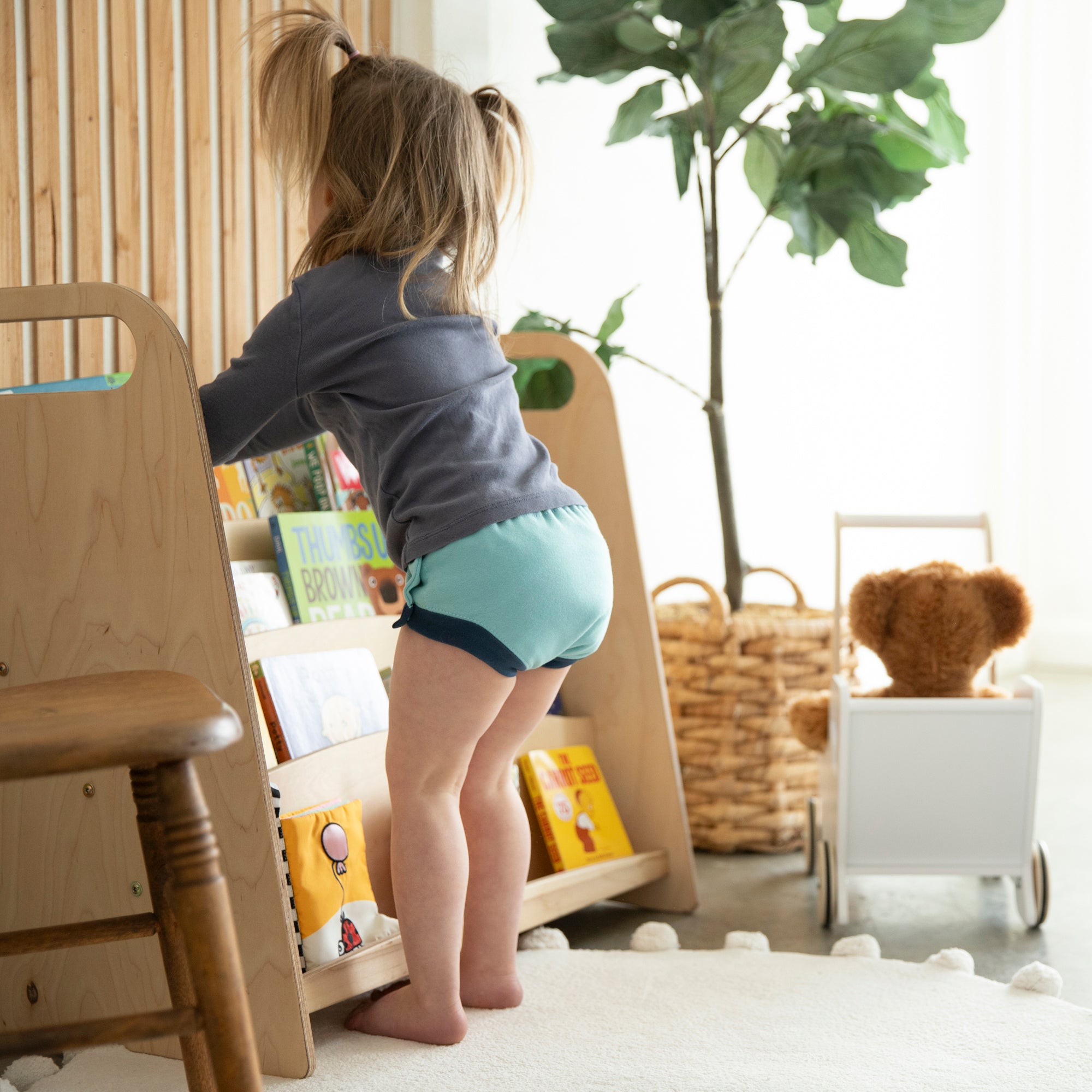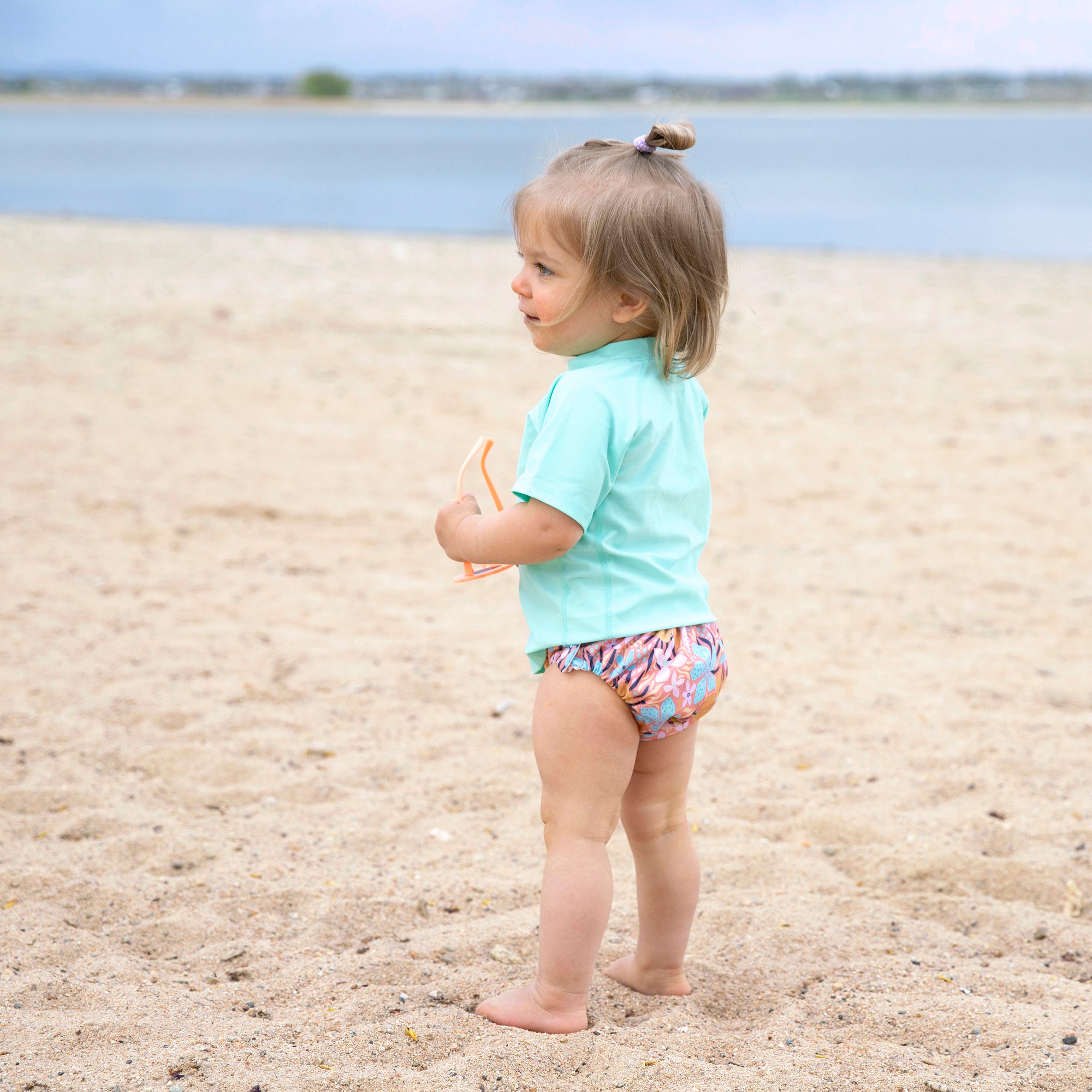The answer to this question may seem simple – just change them when they are dirty or wet! However, there is more to it than that. Since babies of different ages will have different outputs, you will need to have a general idea of when you will need to check the diaper, and how many diapers you need to have on hand for each age. Some babies may not let you know when they are wet or dirty, so checking the diaper periodically may be necessary. If switching from disposables to cloth, there may be a considerable difference in the amount of diaper changes. As a general rule, diapers should be checked every 1.5-2 hours during the daytime. Older babies may go longer in between changes. You will quickly find out what the elimination routine is for your baby, and will adjust according to their own personal needs. The absorbency of the diaper will also determine how often baby needs to be change. Some babies do not want to stay in a soiled or wet diaper for any amount of time, whereas some may seem indifferent. Keep in mind that a soiled (number 2 ) diaper should be changed immediately – day or night. New or expecting parents may not realize that babies have different outputs at different times during the day. I have researched and compiled some information on the fluid output of children that may help give an idea of how it can change including factors of age and time of day. Estimated fluid output in newborns in ounces:
|
7 AM-3 PM |
3 PM-11 PM |
11 PM-7 AM |
24 hours |
| Total |
19.49 oz. |
26.12 oz. |
31.93 oz. |
77.50 oz. |
| 2 hr. average |
4.87 oz. |
6.53 oz. |
7.98 oz. |
6.46 oz. |
| 4 hr. average |
9.75 oz. |
13.06 oz. |
15.97 oz. |
12.92 oz. |
As you can see, newborns will most likely put out more during the nighttime hours. This is, of course, an estimate. Your child’s output will be determined by many factors including diet, age, health, medications, quantity of fluids consumed, and time those fluids are consumed.
The chart below will give you an idea of what the liquid output at different ages looks like.
| Stage |
Age |
Weight |
Per hr. |
Every 2 hrs. |
Every 4 hrs. |
| Newborn |
0-4 weeks |
6-12 lbs. |
3.23 oz. |
6.46 oz. |
12.92 oz. |
| Infant |
1-12 mo. |
12-28 lbs. |
.6-1.2 oz. |
1.2-2.4 oz. |
2.4-4.8 oz. |
| Toddler |
1-3 yrs. |
20-40 lbs. |
1.96-2.8 oz. |
3.92-5.6 oz. |
7.84-11.2 oz. |
| Preschool |
3-5 yrs. |
30-50 lbs. |
1.96-2.8 oz. |
3.92-5.6 oz. |
7.84-11.2 oz. |
| Schoolage |
5-11 yrs. |
40-80 lbs. |
1.96-2.8 oz. |
3.92-5.6 oz. |
7.84-11.2 oz. |
Newborns will have a higher fluid output overall, but it is released more frequently. This is understandable, considering that they are on a liquid diet. Older babies will need fewer changes as they start to eat solid foods and have more control and a greater bladder capacity. You will notice that the fluid output seems to remain the same after the toddler years. This is most likely due to the fact that babies and toddlers tend to drink a lot more than older kids in comparison to their body mass. As a convenience to our customers, Thirsties has recommendations on how many diapers you will need for each age. This information can be found on our FAQs section of our website: Newborn: 20-24 diapers 6-12 months: 14-18 diapers 12-24 months: 12-16 diapers Potty Learning: 4-8 diapers If using a two piece system, you will need a waterproof cover as well as the absorbent diaper. Below are the cover quantity recommendations: Newborn-9 months: 1 wrap for every 3 diapers 9 months-18 months: 1 wrap for every 4 diapers 18 months to potty: 1 wrap for 5 every diapers The numbers above are for a two day supply, as we recommend washing cloth diapers every other day. Wipe covers down in between changes, and wash every 5 uses. Soiled covers should be rinsed and pretreated for stains, then hand-washed or put in the diaper pail for laundering. Adding an insert to any diaper will boost its absorbency, and is recommended for nighttime use past the infant stage. We don’t want you waking up any more than you have to! You can also find package recommendations on the following Thirsties blog articles:
Diapering Full-Time with the Duo All in One Thirsties Duo Fab Fitted Startup Package Getting Started With the Thirsties Duo Wrap and Duo Hemp Prefold Getting Started with the Thirsties Duo Diaper System Happy cloth diapering! If you have any questions, please feel free to let us know. Resources include:
http://content.lib.utah.edu/cdm4/document.php?CISOROOT=/undthes&CISOPTR=5063&REC=17 http://www.easycalculation.com/medical/Pediatric_urine_output.php http://www.clipboardsecrets.com/2006/06/15/is-your-urine-output-sufficient.html
Written by Sonya Choron 8/25/13






I love charts and this was quite helpful. My husband was asking since cloth diapers don’t have the pretty little “blue-line” that many disposables do!
Thanks for the info! I’m wondering though how much frequency of changing diapers contributes to the baby/child’s awareness of their output – and therefore helps potty training later.
Wow- thanks! As a new cloth diapering momma I wasn’t sure what to expect. This certainly gives me an idea. I can’t believe the difference between newborn/infant!!
Very informative. I think this will help with the transition to cloth diapers, especially as my little one does not cry when she is wet.
I hope to cloth diaper my next, so this post is very helpful! Thank you!
You're viewing 16-20 of 36 comments